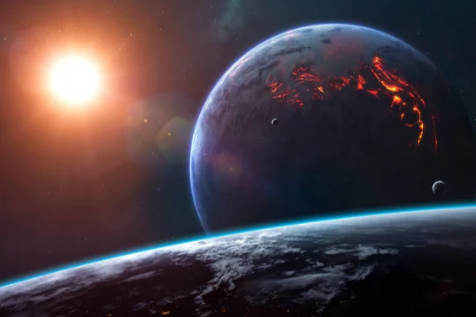Planet K2-18 b, an exoplanet, that may contain Methane and carbon dioxide has been discovered on a far-off exoplanet by scientists using the Webb telescope. The prospective marine planet is a suitable contender to be explored for life because of this.
Table of Contents
Researchers examined the planet K2-18 b with the James Webb Space Telescope and discovered the presence of compounds that contain carbon like methane and carbon dioxide.
Recent research indicates that the planet may contain oceans of water spanning most of its surface and that its atmosphere is hydrogen-rich. It is 8.6 times as big as Earth.
Planet K2-18 b
Super-Earth-sized exoplanet K2-18 b revolves around a M-type star. It has an 8.92 Earth mass, orbits its star in 32.9 days, and is 0.1429 AU away. It was found and was made public in 2015.
The celestial body K2-18 b circles the cold dwarf star K2-18 in the ideal Goldilocks area, where it receives sufficient illumination to maintain water’s liquid state but not enough to cause it to boil it off into vapor. It is located in the constellation Leo, approximately 120 light-years from Earth.
Research indicates that it is a possible type of planet called a hycean world which is described as a hot, water-covered planet with a hydrogen envelope. Hycean worlds, in the opinion of some researchers, are ideal locations to look for signs of existence.
Atmosphere and Climate
According to the telescope’s observations, K2-18b possesses a hydrogen-rich atmosphere. Between 0.7 and 1.6% of the planet’s atmosphere is made up of water vapor, whereas methane levels may be either normal for this type of planet or severely depleted, and levels of ammonia appear to be unmeasurably low.
Merely a maximum limit on their amounts (a few percent) has been set for carbon oxides, which were not stated. The planet’s atmosphere comprises only 6.2% of its total mass, and it is likely similar to the environments of Uranus and Neptune in makeup.
Nikku Madhusudhan, the research paper’s principal author, said that while smaller planets with rocks have historically been the main topic of the search for extraterrestrial life, atmospheric measurements on bigger Hycean planets are easier.
According to scientists, the planet may have a water ocean buried beneath a hydrogen-rich atmosphere due to a high level of methane, carbon dioxide, and a lack of ammonia.
The research also records a potential identification of a chemical known as dimethyl sulfide. This can only be generated by life on the earth. Oceanic algae emit the majority of the dimethyl sulfide that exists on Earth.
However, the conclusion regarding the atmosphere and climate on the planet is not entirely reliable. He also said that the future Webb measurements should be able to ascertain whether DMS is actually present in K2-18’s atmosphere at measurable levels.
The researcher also said that even though K2-18b is located in the zone of habitability and contains carbon-containing compounds, this is not a guarantee that it can sustain life. Moreover, given that its radius is 2.6 times that of Earth, it probably possesses a sizable layer of high-pressure frost.
Conclusion
The James Webb Space Telescope has revealed intriguing hints about the enigmatic K2-18 b in its attempt to unravel the mysteries of far-off worlds.
Although the finding of dimethyl sulfide raises the likelihood of life, it still remains an unsolved mystery. The future looks bright as Webb’s observations might reveal more mysteries buried beneath K2-18 b’s surroundings.
The vastness and high-pressure ice of the planet serve as stark reminders that habitation and the continued existence of life are complex calculations that go beyond fundamental elements, in spite of its appealing characteristics.
K2-18 b is a fascinating celestial wonder that inspires us to keep going in our cosmic research with astonishment.












